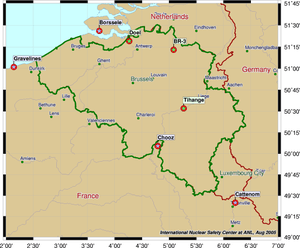Electricity sector in Belgium

The electricity sector in Belgium describes electricity in Belgium. Production by power source in 2009 was 53% nuclear, 40% fossil electricity and 7% renewable electricity. 2% of production was exported in 2009. In 2008 import was 11%. Belgium is highly nuclear dependent country where the share of renewable electricity has been low. The share of renewable electricity was about 2% in 2005. Plan for 2020 is wind 10.5 TWh (9.5%), biomass 11 TWh and PV 1 TWh.
Total electricity consumption was 91 TWh in 2008. Finland had about same consumption 87 TWh with only half of Belgium’s population.[1] In 2009 consumption was 8,152 kWh per person.
Electricity per capita by power source
In 2008 Belgium consumed electricity 8,961 kWh/person. EU15 average was 7,409 kWh/person.[2]
| Electricity per capita in Belgium(kWh/person)[2] | ||||||||||||
|---|---|---|---|---|---|---|---|---|---|---|---|---|
| Use | Production | Import/Exp. | Imp./Exp. % | Fossil | Nuclear | Nuc. % | Other RE | Bio+waste | Wind | Non RE use* | RE % | |
| 2004 | 8,967 | 8,219 | 749 | 8.3% | 3,323 | 4,540 | 50.6 % | 168 | 187 | 8,612 | 4.0% | |
| 2005 | 8,913 | 8,311 | 602 | 6.8 % | 3,351 | 4,546 | 51.0% | 200 | 215 | 8,499 | 4.7% | |
| 2006 | 9,111 | 8,466 | 645 | 7.1% | 3,343 | 4,581 | 50.3 % | 234 | 308 | 8,568 | 5.9% | |
| 2008 | 8,961 | 7,962 | 999 | 11.1% | 2,997 | 4,295 | 47.9 % | 252 | 418 | 8,291 | 7.5% | |
| 2009 | 8,152 | 8,319 | -167 | -2.0 % | 3,330 | 4,388 | 53.8% | 74* | 436 | 93* | 7,549 | 7,4% |
| * Other RE is waterpower, solar and geothermal electricity and wind power until 2008 * Non RE use = use – production of renewable electricity * RE % = (production of RE / use) * 100% Note: European Union calculates the share of renewable energies in gross electrical consumption. | ||||||||||||
Import
The electricity import in Belgium was 11 TWh in 2008. This was seventh highest import in the world behind Brazil 42 TWh, Italy40 TWh, USA 33 TWh, Netherlands 16 TWh, Finland 13 TWh and UK 11 TWh. [1]
Most recent data shows that this deficit has been reduced to 9.6 TWh in 2013.
Nuclear power
Domestically produced nuclear power accounted for 53% of the electricity consumption in Belgium, in 2009. This is among the highest nuclear dependencies in the Europe. Less than France(79%) but more than Switzerland(40%) and Sweden(35-40%).
Renewable electricity
According to the National Renewable Energy Action Plan Belgium has 13% RES target in 2020, up from 2% in 2005. Renewable electricity will represent the largest share of RES in 2020 (20.9%). The annual production in 2020 is estimated at wind 10.5 TWh, biomass 11 TWh and PV 1 TWh. Wind energy will cover 9.5% of electricity. Wind capacity is estimated as 4,320 MW in 2020.[3]
Global warming
Emissions of carbon dioxide in total, per capita in 2007 were 10 tons CO2 compared to EU 27 average 7.9 tons CO2.[4]
See also
| Wikimedia Commons has media related to Power plants in Belgium. |
References
- 1 2 IEA Key stats 2010 pages 27, 48
- 1 2 Energy in Sweden, Facts and figures, The Swedish Energy Agency, (in Swedish: Energiläget i siffror), Table: Specific electricity production per inhabitant with breakdown by power source (kWh/person), Source: IEA/OECD 2006 T23, 2007 T25, 2008 T26, 2009 T25 and 2010 T49.
- ↑ EWEA March 2011 pages tables 43-47, national plan 58
- ↑ Energy in Sweden 2010, Table 1: Emissions of carbon dioxide in total, per capita and per GDP in EU and OECD countries, 2007 2010 Table 1